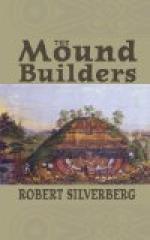On the west, there is erected a mound, 170 feet long and 14 feet in height, which overlooks the whole works, and has been styled “the Observatory”. To the east is a true circle 2,880 feet in circumference, the wall being 6 feet in height. To the north of this is an avenue leading from the circle to an octagon of fifty acres, in the wall of which are eight gateways, which, however, are covered by mounds five feet in height. From this strange eight-sided figure run three parallel walls. Those to the south are about two miles in length, and those running towards the east are each about one mile in length.
About a mile east, where the middle line of parallel walls terminates, is a square containing twenty acres, within and around the walls of which are disposed seven mounds. To the north-east of this is an elliptical work of large dimensions. On the south-east is a circle, in the centre of which is the form of a bird with wings expanded. The body is 155 feet, the length of each wing 110 feet, and the head of the bird is towards the opening. When this structure was opened, there was found an altar, proving that, in this circular place, this ancient people must have assembled for worship.
There is a place three miles north of Chillicothe, where an extensive enclosure—now called “Mound City”—contains 26 well formed and regularly disposed mounds, covering an area of 13 acres. Many of those mounds contained altars at their base, but have been subsequently converted into ordinary mounds. One mound, which is 90 feet in diameter at the base and 7-1/2 feet in height, contained an altar, within the basin of which was found a layer of solid ashes three inches thick, in which were numerous pieces of pottery and shell-beads. On the top of the altar was a layer of sand, then gravel for two feet, then a thin layer of sand, then one foot of gravel.
Buried three feet below the apex of the mound, were found two well developed and highly preserved skeletons, which, however, were not those of Mound-builders, but rather of the Indians who were buried there long after the mounds were abandoned. One altar was covered by a layer of opaque mica, which must have been brought from a great distance. In the centre of the basin was found, besides numerous other relics, a large heap of burned human bones, which would indicate it an altar of human sacrifice. From other evidences, we may safely conclude that they were Sun or Fire-worshippers. As to the cause of these altars being afterwards changed into common mounds, it is difficult to determine. Many such mounds are found, which for a long time were used for purposes of sacrifice, and then covered over by many feet of earth. We may not wonder, however, at this, as even now many old churches are abandoned to the fate of being turned into dwelling houses or barns.
It may be, however, that after the decease of the priest who performed his sacred functions before the altar for many years, the people, to whom he had so long ministered, laid, or burned his remains on the altar which they so much revered, and then, like the ancient builders of the pyramids, erected a monument to departed worth, and during the strange ritual deposited beside the respected remains whatever implements or ornaments they could part with, in honor of the dead.




